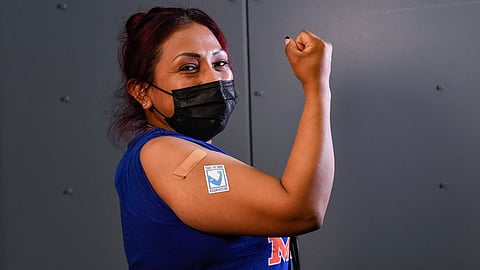DOH Launches Mobile Vaccine Outreach Program as State Approaches Vaccination Goals
by Luke Schaefer
Thursday, June 4, marks 500 days since statewide efforts to curb the COVID-19 epidemic began. As of today, Washington has surpassed 7 million vaccine doses with more than 62% of Washingtonians ages 16 and over — or around 3.8 million people — receiving at least one dose.
In a press briefing Tuesday morning, Washington Department of Health (DOH) Secretary of Health Umair Shah expressed that high vaccination rates may lead to the elimination of capacity constraints on Washington businesses even before the state's proposed date of June 30. This is entirely possible, provided that vaccination rates reach the 70% target in that time.
While it appears the finish line may be within view, Shah noted that a shift from increasing the supply of vaccines to maintaining demand for them is vital if the State hopes to reach their goal in time.
"… there are clusters or pockets across Washington of people who have not gotten vaccinated for one reason or another, even though we know it protects them and they know it protects them," said Shah. "Getting vaccinated has never been easier than it is now. We want to make sure that the vaccine choice is the easy choice, that it's the right choice, and now is the time to take advantage of convenient drive-through popup and mobile options."
June 1 saw the rollout of the DOH's Care-a-Van program, which utilizes vans as mobile vaccination centers in order to increase vaccine access in what Shah called the state's "priority communities." These include counties with higher rates of race or ethnicity equity gaps, disproportionately affected communities, areas with recent outbreaks, and more sequestered regions.
The DOH implemented the Care-a-Van program to improve what they call vaccine equity through mobility and community engagement. Vans can be requested for public gatherings such as church events, for example, and the DOH plans to utilize the program to foster community health through events following the COVID pandemic.
Although positive cases and COVID hospitalizations are declining, unvaccinated patients are still roughly 20 times more likely to require a doctor than vaccinated ones. For Washingtonians ages 60 and up, the hospitalization rate of unvaccinated seniors versus vaccinated ones is currently 13:1.
While raising vaccine demand is a priority for older patients, vaccine rollout for younger ones is finally beginning to take shape. More than 105,000 patients, roughly 25% of kids ages 12—15, have received their first dose of the Pfizer vaccine since they became eligible three weeks ago.
Second doses for the age group's earliest patients will begin being administered this week, meaning many kids will be fully vaccinated before their summer vacation begins later this month.
Vaccine equity among communities is perhaps the DOH's highest priority, necessary to combat what Shah calls the "tale of two societies."
"We have one society that is vaccinated fully and protected fully and going about its business … without as much concern for COVID-19. And yet we also have another society where people are not vaccinated and those individuals are still trying to go about those [same] activities as the vaccinated people are, but they are at risk," said Shah.
While vaccine rollout in Washington's more rural communities seems to be amping up, vaccine hesitation is still a prevalent issue in some communities. A national survey found this year that 43% of Paific Islanders ages 18—44 were reluctant to receive the vaccine. In areas with high Pacific Islander populations such as Snohomish and Clark counties, vaccination rates are trailing at around 20—30%, compared to the 71% rate in King county.
Joseph Seia, the executive director of the Pacific Islander Community Association of Washington, called these rates "dismal" and expressed relief towards efforts to mobilize help for Washington's Pacific Islander population.
"… all of the work that the Department of Health and County Public Health has done to just aggregate native Hawaiian and Pacific Islander data has been tremendous. We do see the disparities and we are looking at strategizing at a community level that we need to in order to support our Pacific Islander peoples."
PICAWA has created a vaccination toolkit written in 12 different Pacific Islander languages in order to help these communities get straight facts about the vaccine. It can be found at www.picawa.org
As of now, both Pfizer and Moderna have submitted the proper paperwork to the FDA and are currently seeking full approval for their respective vaccines. Both were approved for emergency use authorization late last year and are now much closer to formal approval now that six months of safety data have been gathered.
Luke Schaefer is a freelance journalist and screenwriter based in Seattle. He graduated from UW with a bachelor's degree in journalism in 2021. He loves his bike, the films of John Waters, and the Reubens at Lost Lake Cafe. You can find his other writings athotluke.com.
📸 Featured Image: Maria Diaz receives the COVID-19 vaccine. Photo by Marc A. Hermann / MTA New York City Transit via Flickr, published under a Creative Commons license (CC BY 2.0).
Before you move on to the next story …
The South Seattle Emerald™ is brought to you by Rainmakers. Rainmakers give recurring gifts at any amount. With around 1,000 Rainmakers, the Emerald™ is truly community-driven local media. Help us keep BIPOC-led media free and accessible.
If just half of our readers signed up to give $6 a month, we wouldn't have to fundraise for the rest of the year. Small amounts make a difference.
We cannot do this work without you. Become a Rainmaker today!
Help keep BIPOC-led, community-powered journalism free — become a Rainmaker today.


